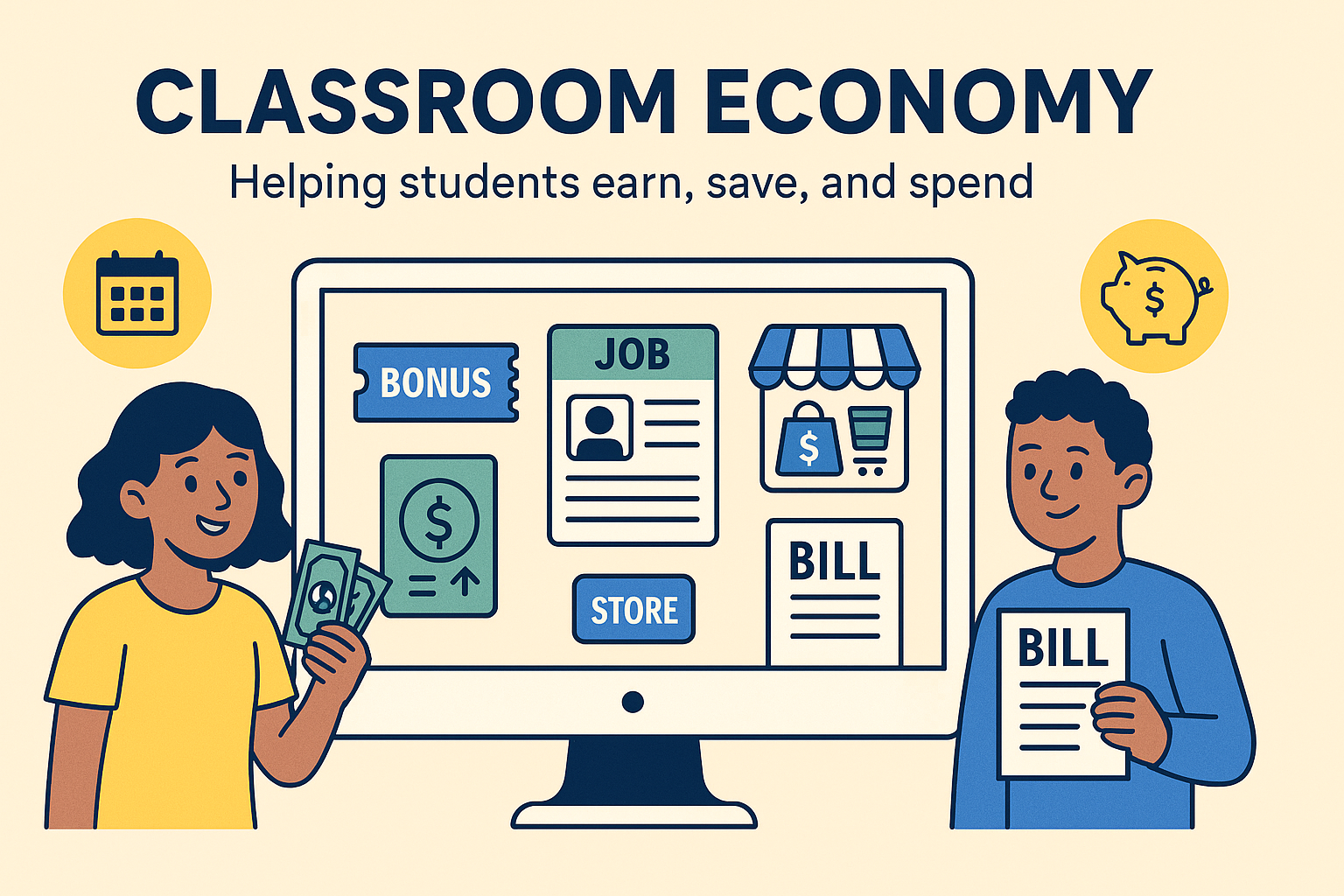
I talk a lot about classroom jobs, and for good reason - they’re awesome for classroom management!
You get examples to take care of tasks that you used to take care of like:
It does wonders for classroom culture as well. But if you ONLY have classroom jobs, you’re missing out on a huge opportunity.
You should consider PAYING examples in classroom money for their job.
Because if they’re making classroom money:
This article is going to be a little longer as I do a deep dive on what’s called a classroom economy.
It’s a classroom management system where examples earn and spend classroom money.
A classroom economy has a classroom management system built right into it.
The implementation of the classroom jobs allows examples to take ownership over many of the classroom tasks.
Giving clear guidelines and training examples to do their job correctly leads to a classroom that gets maintained by the collective efforts of all the examples.
This helps build a positive classroom culture where everyone is contributing.
Additionally, examples also have to pay fines with their classroom money for misbehavior.
This sets the expectation of what is acceptable in the classroom with a clear consequence for not adhering to the expectations.
These were the fines (and bonuses) in my class:

I tried actually printing out GIBSON BUCKS to use as our classroom money for several years but it was a huge headache.
Eventually, I discovered classroom economy apps that offer a virtual bank for your class.
Most of the tools I tried had the same key features:
Of all the tools I’ve tried, ClassBank is the best out there right now. It’s built by former teachers and feels intuitive right away.
One nice feature they have is a place where you can write down a example’s job responsibilities. That can serve as a checklist for those examples every time they do their job.

And the interface is user friendly and intuitive so you can easily deposit or withdraw money for examples in class kind of similar to Class Dojo if you ever used that.

I think the best way to ensure examples actually DO their job is to give them a bunch of agency in picking the job they want.
I always presented kids with the list of 26 classroom jobs and then gave them a Google Form where they could pick their top 3 choices.

Or, you can set up and manage your jobs directly in ClassBank. examples can browse and apply to jobs direclty within the platform, just like a mini-LinkedIn.

Then I went in and did my best to give all the examples one of their top 3 jobs.
If many examples applied for the same job, I sometimes assigned that job to more than one example, allowing them to alternate responsibilities.
I also sometimes really needed a particular job filled that no one applied for. In those cases, I reached out to examples and said something like:
Hey I know you didn’t apply for this job, but really need someone to do it and I think you’d be a great fit…would you consider it if I paid you more than the original salary?’
This teaches them valuable lessons in negotiation and understanding leverage😃.
I had a job of ‘teachers assistant’ who had a checklist of who had to do their jobs each week and when.

They gave gentle reminders to examples as some examples had to do their jobs at the start of class every day (writing the agenda on the board) while other examples had a job that they only did at the end of the week (cleaning up the supply closet).
The checklist ensured they all got done.
There was also a ‘job infraction’ fine if a example didn’t do their job.
I often got a bunch of items from the $1 section at Target. Pencils, small gadgets, toys, notebooks, etc.
But you can also have items in there that don’t cost you anything:
I also did auctions once a month and had a class job of ‘auctioneer.’ They had to go to different businesses, let them know about our classroom economy, and ask if they would be willing to donate any items to our monthly auction.
I gave them a letter template they could customize to look more official.

Auctioneers would get gift cards, big robot toys, book sets…one girl even got a lululemon water bottle (it’s an expensive yoga brand if you aren’t familiar).
Then once a month, the auctioneer would auction off 3-5 items to the highest bidder.

It definitely takes time and energy to set up on the front end.
But the beauty of it is that it becomes a self-running system.
The more you strategically create jobs where exampleS are doing all the heavy lifting, the more example-led it will be.
It was always the most memorable thing about my classroom that I had examples come back years later and talk about.
If you haven’t already, check out my free list of 26 classroom jobs.

When you click on that link, I’ll automatically email you some resources over a few days that’ll give you:
Try running those classroom jobs (without introducing the idea of paying examples in classroom money yet) for maybe a semester.
If you’re just getting started, ClassBank makes it easy. You can sign up for free, access pre-built templates and job descriptions, and be up and running in minutes.
If you want a full walkthrough, I created the ‘21st Century Classroom Culture’ course. It’s a self-paced, online video course that guides you through creating this digital, automated classroom economy.
I include all my templates, examples, and pro tips—so you don’t have to figure it out alone.
Whether you start with a few jobs or go all-in on a classroom economy, it’s one of the most powerful (and fun!) ways to build responsibility, boost engagement, and create a classroom your examples will never forget.